| Revision as of 14:15, 5 August 2012 editSantos30 (talk | contribs)1,312 edits →Chronology← Previous edit | Revision as of 04:09, 8 August 2012 edit undoGerakibot (talk | contribs)11,103 editsm r2.6.5) (Robot: Modifying nah:Īpān MēxihcoNext edit → | ||
| Line 346: | Line 346: | ||
| {{Link FA|pt}} | {{Link FA|pt}} | ||
| {{Link FA|af}} | {{Link FA|af}} | ||
| ] | ] | ||
| ] | ] | ||
| Line 380: | Line 381: | ||
| ] | ] | ||
| ] | ] | ||
| ] | ] | ||
| ] | ] | ||
| ] | ] | ||
Revision as of 04:09, 8 August 2012
 | |
| Use | National flag and ensign |
|---|---|
| Proportion | 4:7 |
| Adopted | September 16, 1968 |
| Design | A vertical tricolor of green, white and red with the Mexican coat of arms charged in the center. |
The flag of Mexico (Spanish: Bandera de México) is a vertical tricolor of green, white, and red with the national coat of arms charged in the center of the white stripe. While the meaning of the colors has changed over time, these three colors were adopted by Mexico following independence from Spain during the country's War of Independence, and subsequent First Mexican Empire. The current flag was adopted in 1968, but the overall design has been used since 1821, when the First National Flag was created. The current law of national symbols, Law on the National Arms, Flag, and Anthem, that governs the use of the national flag has been in place since 1984.
Red, white, and green are the colors of the national liberation army in Mexico. The central emblem is the Aztec pictogram for Tenochtitlan (now Mexico City), the center of their empire. It recalls the legend that inspired the Aztecs to settle on what was originally a lake-island. The form of the coat of arms was most recently revised in 1968. A ribbon in the national colors is at the bottom of the coat of arms. Throughout history, the flag has changed four times, as the design of the coat of arms and the length-width ratios of the flag have been modified. However, the coat of arms has had the same features throughout: an eagle, holding a serpent in its talon, is perched on top of a prickly pear cactus; the cactus is situated on a rock that rises above a lake. The coat of arms is derived from an Aztec legend that their gods told them to build a city where they spot an eagle on a nopal eating a serpent, which is now Mexico City. The current national flag, the Fourth National Flag, is also used as the Mexican naval ensign by ships registered in Mexico.
History
See also: List of Mexican flags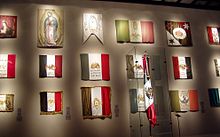
Before the addition of the first national flag, people flags used during the War of Independence from Spain had a great influence on the design of the first national flag. It was never adopted as an official flag, but many historians consider the first Mexican flag to be the Standard of the Virgin of Guadalupe, which was carried by Miguel Hidalgo during the Grito de Dolores on September 16, 1810. The Standard became the initial symbol of the rebel army during the Mexican War of Independence. Various other Standards were used during the war. José María Morelos used a flag with an image of the Virgin to which was added a blue and white insignia with a crowned eagle on a cactus over a three-arched bridge and the letters V.V.M. (Viva la Virgen María – "long live the Virgin Mary"). The Revolutionary Army also used a flag featuring the colors white, blue and red in vertical stripes. The first use of the actual colors—green, white and red—was in the flag of the unified Army of the Three Guarantees (pictured above) after independence from Spain was won.
While similar to the national flag that is used today, the eagle in these arms is not holding a serpent in his talons and a crown has been affixed to the head of the eagle to signify the Empire. Variants of this flag that appeared in this period also included a naval flag that had the tricolor pattern, but only contained the eagle with the crown above its head. The military also used a similar, square, flag, but the eagle was larger than on the national flag. The national flag was officially decreed by Agustín de Iturbide in November 1821 and first officially used in July 1822. This flag was no longer used upon the abolishment of the empire.
- The first national flag was established in 1821, the first year of Mexican recognized sovereignty. The imperial government that was set up chose a tricolor flag of green, white and red and charged with the national coat of arms. The official decree stated that
Sole article:(...) the national flag and flags of the army shall be tricolor, adopting forever the colors green, white and "encarnado" arranged vertically, with the crowned eagle in the center of the white stripe, according the following design...
- The second national flag that was adopted around the same time as the establishment of the first federal republic in 1823. The new flag chosen for the republic in April of that year, the only difference being the appearance of the central emblem. The crown was removed from the eagle's head and a serpent was placed in the eagle's right talon. Another addition to the flag is a branch of oak and laurel branches, a tradition that was carried over to the current flag. This flag was discontinued in 1864 upon the dissolution of the federal republic.
- The third national flag was that of the Second Mexican Empire. Once again, the national flag used the green, white and red tricolor pattern with the white stripe being charged with the national arms. However, the ratio of the flag was changed from 4:7 to 1:2 and four eagles, which had crowns above their heads, were placed at each corner of the flag. The design, which was ordered by the Emperor Maximilian, gave the arms a look similar to the French Imperial arms, but he decided to add a bit of "Mexican flavor" to the flag. The coat of arms was described in a decree issued in November of 1865 as;
(...) oval in shape in blue; in the center is depicted the eagle of Anahuac, in profile and passant, supported by a cactus, supported, in turn, by a rock sunk on water, and ripping a snake. The border is gold charged by a garland of encino and laurel. The crest is the Imperial Crown. As supporters, two griffins from our elders' arms, their upper half in black and the lower in gold; behind the scepter and sword in saltire. The shield is surrounded by the collar of the Order of the Águila Mexicana, and the motto: "Equidad en la Justicia" (...).
- The first national flag was established in 1821, the first year of Mexican recognized sovereignty. The imperial government that was set up chose a tricolor flag of green, white and red and charged with the national coat of arms. The official decree stated that

The current national flag was adopted on September 16, 1968, and was confirmed by law on February 24, 1984. The current version is an adaptation of the design approved by presidential decree in 1916 by Venustiano Carranza, where the eagle was changed from a front-facing to a side-facing position. Before the adoption of the current national flag, official flags have been used by the government. All of these flags used the tricolor pattern, with the only differences being the changes in the coat of arms, which was still charged in the center of the white stripe. One possible reason for the 1968 flag and arms change was that Mexico City was the host of the 1968 Summer Olympic Games. Around this same time period, the plain tricolor flag that Mexico used as its merchant ensign was also legally abandoned. The reasoning is that without the coat of arms, the flag would not be the Mexican flag; it would have become the Italian flag.
There was also debate in 1984 about how the coat of arms will be depicted on the national flag, including the reverse. To solve this problem, a PAN deputy proposed a change to the Law of the National Arms, Flag and Anthem that same year to allow for the eagle to face to the right when the reverse of the flag is displayed. In 1995, the law was changed to include the following;
When the National Arms is reproduced in the reverse side of the National Flag, the Mexican Eagle will appear standing in its right grasp, holding with the left one and the beak the curved serpent.
Design and symbolism

The official design of the Mexican Flag can be found in Article 3 of the Law on the National Arms, Flag, and Anthem, passed in 1984. While the exact shades of the flag have not been defined by law, the Interior Ministry, (Secretaría de Gobernación) has suggested the following tones in the Pantone system. The article dictates what must be featured on the flag and also its proportions. Copies of the national flag which are made according to this law are kept in two locations: the General National Archive (Archivo General de la Nación) and the National Museum of History (Museo Nacional de Historia).
Art. 3: The Bandera Nacional is a rectangle divided into three vertical stripes of identical measures, with the colours placed in the following order from hoist to fly: green, white, and red. Centred in the white stripe, the National Coat of Arms has a diameter of three-fourths the width of the white stripe. The proportion of the flag is four to seven (Ratio 4:7). It could carry a rope or tie of the same colours below the truck.
| Colour scheme | Green | White | Red | |||
|---|---|---|---|---|---|---|
| Pantone | 3425c | Safe | 186c | |||
| RGB | 0-104-71 | 255-255-255 | 206-17-38 | |||
| CMYK | 100-0-32-59 | 0-0-0-0 | 0-92-82-19 | |||
| Web colors | 006847 | FFFFFF | CE1126 | |||
Common mistakes of construction
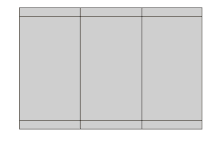
It is a common mistake when constructing the flag of Mexico to take the Mexican coat of arms and place it in the center of the white stripe, using the Italian flag as the base design. However at the time of the flag's adoption, the Italian tricolour was in use.
This error occurs due to the fact that some people incorrectly believe the only difference between the two flags is the coat of arms in the Mexican national banner. Both flags use the same colors (green, white and red), but the Mexican flag has darker shades of green and red. Most importantly, these flags present a different aspect ratio (proportions), which gives each one a unique look. The Italian flag aspect ratio is 2:3 (1 to 1.5), more squarish in shape, while the Mexican flag aspect ratio is 4:7 (1 to 1.75), resulting in a longer shape.
Protocol
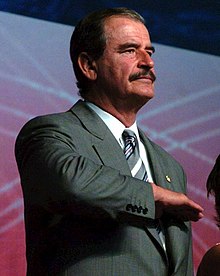
When the flag is paraded in front of a crowd, those in military uniform must present a salute according to military regulations. Civilians who are present give the following salute to the national flag: standing at attention (firme), they raise their right arms and place their right hands on their chests, in front of the heart. The hand is flat and the palm of the hand is facing the ground. This salute is known as the El saludo civil a la Bandera Nacional ("The Civil Salute to the National Flag"). When the President is acting in the capacity of the Head of the Armed Forces, he salutes the national flag with a military salute. When the national anthem is played on television to open or close daily programming, the national flag will be shown at the same time. During certain times of the year, the flag is flown by both civilians and government personnel. Mostly, these events coincide with national holidays and days of significance to the country. During some of these occasions, the flag will be flown at half-mast to honor the death of important Mexicans. These dates are listed in Article 18 of the Law of the National Flag, Arms and Anthem. The national Día de la Bandera (Flag Day) celebration occurs on February 24. On this day in 1821, all the factions fighting in the War of Independence joined together to form the Army of the Three Guarantees in response to the Plan de Iguala, which was signed by Vicente Guerrero and Agustín de Iturbide, declaring Mexico officially an independent country. General Vicente Guerrero was the first military official who swore allegiance to the national flag. Another flag tradition is that before every Olympics in which Mexico is a participant, the President hands a flag over to the flag bearer, chosen by their peers, to carry with them to the host city.
Civil ceremonies
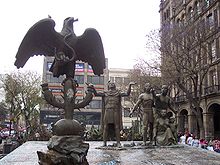
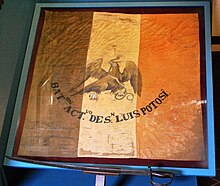
The flag songs are dedicated to the flag day, it is a national holiday in Mexico. Flag Day is celebrated every year on February 24 since its implementation in 1937. It was established by President of Mexico General Lázaro Cárdenas before the monument to General Vicente Guerrero, first to pledge allegiance to the Mexican flag and Agustin de Iturbide;
|
|
|
|
Variants
 | |
| Proportion | 4:7 |
|---|---|
| Adopted | De facto |
 | |
| Cravat | |
 | |
There are two variants of the national flag that are mostly used by the state and federal governments, the difference between the national flag and the variants are the designs of the coat of arms. In the first variant, which is used by the President of Mexico and secretaries of federal bodies, the entire coat of arms is coloured gold, with the exception of the tricolour ribbon, which is green, white and red, and with the stone, lake and talons of the eagle coloured in silver. In the second variant, the entire coat of arms is coloured gold, even the ribbon, lake, stone and talons. The second variant is used mostly by State governments and federal bodies who are not able to use the first variant.
Law articles
- In Article 3 of the Law on the National Arms, Flag and Anthem (Ley sobre el Escudo, la Bandera y el Himno Nacionales) also describes that the national flag can be decorated with a special tie called a corbata (cravat). The corbata is composed of a bow, two ribbons of different length and both ribbons are attached with a golden tassel called fringe. The corbata is placed on the top of the flag at the point where the truck is, and the colours of the corbata match that of the national flag. Organisations and political parties can adopt their own corbatas, such as the National Action Party (PAN), which uses a white corbata with blue fringes.
- In Article 3 of the Flag Law does not give an official symbolism to the colors, other meanings may be given to them. Other groups have used the national colors as part of their own logos or symbols. For example, the Institutional Revolutionary Party (PRI) political party has adopted the national colors as part of their logo. Another political party, the Party of the Democratic Revolution (PRD), also had the national colors as part of their logo, but changed them in the 1990s after a controversy surrounding impartiality issues, while the PRI did not. Several states, such as Querétaro and Hidalgo have incorporated either elements of the national flag, or even the entire flag, into their coat of arms.
Regulations for use
The image of the flag is protected under law. A special permit is needed to broadcast its image. In February 2010, MTV Mexico controversially cancelled a much-publicised broadcast of an episode of South Park, called "Pinewood Derby", featuring the flag, because it claimed that the permit had not been issued.
In 2008, Mexican pop singer Paulina Rubio was fined for posing nude wrapped in the flag in a photo shoot for a Spanish magazine.
Chronology

- National Flag (registered)
- National Flag (unregistered)
| Mexico Non-IndependentNorthern America – New Spain – Mexican AmericaAmérica Septentrional – Nueva España – América Mexicana1535–1821 | |||
| Adopted date Related organization |
Promulgated | Flag | Description |
| April 17, 1535 Monarchy |
April 17, 1535 – November 25, 1550Antonio de MendozaViceroy April 29, 1783 – November 3, 1784Matías de Gálvez y GallardoViceroy | 
|
Viceroy of New Spain |
| 1785–1821 Monarchy |
Bernardo de Gálvez y MadridViceroy July 21, 1821 – September 28, 1821Juan O'Donojú y O'RianViceroy | 
|
Viceroy of New Spain |
| Mexico IndependentMexican Nation – Mexican Empire – Mexican Republic – United Mexican StatesNación Mexicana – Imperio Mexicano – República Mexicana – Estados Unidos Mexicanos1821 – 2025 | |||
| Adopted date Related organization |
Promulgated | Flag | Description |
| February 24, 1821 Sovereign Provisional Junta |
Agustín IturbideRoyalistVicente Ramón GuerreroInsurgent | 
|
Flag of the Three GuaranteesDesigned byJosé Magdaleno Ocampo |
| August 24, 1821 Sovereign Provisional Junta |
Agustin IturbideRegency's President | 
|
Flag of the Iturbide's RegencyDesigned byAgustin Iturbide |
| November 2, 1821 Constitutional Congress |
Agustín Iturbide I of MexicoEmperorJosé Manuel de HerreraFirst Minister | 
|
Flag of the First Mexican EmpireDesigned byAgustin Iturbide |
| |||
| April 14, 1823 Constitutional Congress |
October 10, 1824 – April 1, 1829Guadalupe VictoriaPresident January 21, 1858 – December 28, 1862Félix María ZuloagaPresident |

|
Flag of the Mexican RepublicDesigned byConstitutional Congress |
| Government ExecutiveOctober 10, 1824 – May 15, 1867 Reform WarJanuary 21, 1858 – December 28, 1862 |
Regency of the Second Mexican EmpireJuly 11, 1863 – November 18, 1863 | ||
| July 15, 1864 Constitutional Congress |
Maximilian I of MexicoEmperorJuan Nepomuceno AlmonteFirst Minister | 
|
Flag of the Second Mexican EmpireDesigned byFerdinand Maximilian |
| |||
| June 19, 1867 Government Executive |
Benito Pablo Juárez GarcíaPresident | 
|
ReadoptedFlag of the Mexican RepublicDesigned byConstitutional Congress |
| April 1, 1893 Government Executive |
José de la Cruz Porfirio DíazPresident | 
|
Flag of the Mexican RepublicDesigned byTomas de la Peña |
| September 20, 1916 Government Executive |
Venustiano Carranza GarzaPresident | 
|
Flag of the United Mexican StatesDesigned byAntonio Gómez |
| February 5, 1934 Government Executive |
Abelardo Rodríguez LujánPresident | 
|
Flag of the United Mexican StatesDesigned byJorge Enciso |
| September 16, 1968 Government Executive |
Gustavo Díaz OrdazPresident | 
|
Flag of the United Mexican StatesDesigned byFrancisco Eppens Helguera |
| |||
Others
Other flags were flown as Mexican flags, either designed to intimidate the enemy or to act as identification. These flags were considered without subsequent formal documentation as national flag and temporally situated; Flag of Francisco I. Madero (February 9, 1913), Flag of Doliente Hidalgo (January 2, 1812), Flag of José María Morelos y Pavón, Flag of Francisco Villa, Flag of Siera Battalion, Flag of Jalisco Battalion, Libres de Puebla Battalion, Artillería Mina Battalion, Oaxaca Battalion, Toluca Battalion, Flag of Chihuahua Battalion, Flag of Durango Battalion, Flag of San Lorenzo Battalion, Flag of Lanceros Battalion, Flag of San Luis Potosí Battalion, Flag of Aguascalientes Battalion, Flag of Galeana Battalion (May 22, 1864), Flag of San Blas Battalion (September 24, 1846), Flag of Tres Villas Battalion, Flag of Milicias Battalion, Flag of Remixto Battalion, Flag of Quautla Battalion, Flag of 201 Squadron, Etc.
Monumental flags
Main article: Banderas monumentales
In 1999, President of Mexico Ernesto Zedillo started a program erecting giant flags across the country. Directed by the Secretariat of National Defense, the banderas monumentales (monumental flags) were placed in various cities and spots, most of which are of great significance to the nation. In a decree issued on July 1, 1999 by Zedillo, the flags were to be placed in Mexico City, Tijuana, Ciudad Juárez, and Veracruz. The decree also stipulated for the flags to measure 14.3 meters by 25 meters, which are raised on flag poles that are 50 meters high. After these initial monumental flags were created, cities such as Ensenada, Nuevo Laredo and Cancún were reported to have their own monumental flags. Smaller flags, called banderas semi-monumentales, have been erected in smaller towns and at various educational institutes.
As of December 22, 2010 the biggest Mexican flag in the world is now located in Piedras Negras, Coahuila. Located at the Gran Plaza (Great Plaza) right across from International Bridge I connecting Piedras Negras with Eagle Pass, Texas. The pole is 120 meters in height and weighs 160 tons making it the tallest one in Latin America and second tallest in the world. The flag measures 60 by 34 meters and weights 420 kilograms.
Mexico's first largest monumental flag was the one located at the Mirador del Obispado in Monterrey (northeast) with a pole of 120 tons and 100.6 meters in height. The flag measures 50 by 28.6 meters and weighs 230 kilograms, four times the size of most other monumental flags at the time. It is located at the top of the Cerro del Obispado (Bishopric Hill) at an altitude of 775 meters above the sea level (city's altitude 538 meters). There is another monumental flag of a similar size than Monterrey's in the city of Dolores Hidalgo, Guanajuato, cradle of Mexican Independence.
- Example Locations
- Piedras Negras, Coahuila
- Monterrey, Nuevo León
- Querétaro, Querétaro
- Mexico City, Federal District:
- Zócalo, in the city center
- Campo Militar Marte, military base behind Los Pinos
- San Jerónimo roundabout, in Periférico Sur
- Chihuahua, Chihuahua
- Ciudad Juárez, Chihuahua
- Iguala, Guerrero
- Tonalá, Jalisco
- Mérida, Yucatán
- Cancún, Quintana Roo
- Mexicali, Baja California
- Tampico, Tamaulipas
- Tijuana, Baja California
- Nuevo Laredo, Tamaulipas
- Campeche, Campeche
- Veracruz, Veracruz
- Acapulco, Guerrero
- Dolores Hidalgo, Guanajuato
- Pachuca, Hidalgo (Mexico)
- Durango, Durango
See also
References
- ^ Diagrams of historical Mexican flags Template:Es icon
- ^ Juán López de Escalera Diccionario Biográfico y de Historia de México, Editorial del Magisterio, México, 1964.
- "Mexican Empire (1821–1823)". Fotw.vexillum.com. January 17, 2009. Retrieved March 19, 2010.
- January 7, 1822 Decree Establishing the Imperial Flag
- "Mexico (1823-1864/1823-1880)". Fotw.vexillum.com. January 17, 2009. Retrieved March 19, 2010.
- November 1, 1865 Decree on the Imperial Arms
- Page 45 of Adventure Guides Mexico's Pacific Coast by Vivien Lougheed, Hunter Publishing, ISBN 1-58843-395-1
- Flags of the World page "Mexico – Flag without arms" (Archive page)
- Flags of the World page "Mexico – Reverse side of the flag"
- Diario Oficial de la Federación (DOF) of May 9, 1995
- Flags of the World page "Mexico"
- Vexilla mundi page "Mexico"
- Inkscape RGB to CMYK converter (approx.)
- Adobe Photoshop RGB Translator
- Ghisi, Enrico Il tricolore italiano (1796-1870) Milano: Anonima per l'Arte della Stampa, 1931; see Gay, H. Nelson in The American Historical Review Vol. 37 No. 4 (pp. 750-751), July 1932
- "Artículo 41 Ley Sobre el Escudo, La Bandera y el Himno Nacionales (Article 41 of the Law of the National Arms, Flag and Anthem)". Info4.juridicas.unam.mx. Retrieved March 20, 2012.
- 2000 ceremony in Mexico to hand the national flag over from President Zedillo to flag-bearer Fernando Platas for the Sydney Olympics
- Flags of the World page "Mexico – Coat of arms"
- "Photo of the PAN flag with the corbata". Retrieved March 19, 2010.
- Christian Science Monitor article on the PRI logo controversy
- Miglierini, Julian (February 10, 2010). "MTV under fire as it pulls South Park episode in Mexico". BBC News. BBC. Retrieved February 10, 2010.
- SEDENA, Libro de banderas históricas
- Installment of semi-monumental flags in León, Guanajuato September 9, 2005 Template:Es icon
- "En Piedras Negras ondea la bandera de México más grande del mundo". Milenio.com. Retrieved March 20, 2012.
- "Piedras Negras tiene la bandera de MÃxico más grande del mundo". Vanguardia. Retrieved March 20, 2012.
- Por Hilda Aguilar (December 23, 2010). "En Piedras Negras, Izan Bandera más grande del mundo [ESPECIAL] – 23/12/2010 | Periódico Zócalo". Zocalo.com.mx. Retrieved March 20, 2012.
- Secretariat of Interior article Template:Es icon
External links
| Flags of North America | |
|---|---|
| Sovereign states | |
| Dependencies and other territories | |
| National flags and coats of arms | |
|---|---|
| National flags | |
| National coats of arms | |
| "Six flags over Texas" | |
|---|---|
Template:Link GA Template:Link GA Template:Link FA Template:Link FA
Categories: